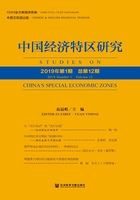
参考文献
[1]师春苗:《改革开放初期深圳经济特区向中央要权纪实》,《红广角》2010年第9期。
[2]苏东斌:《中国经济特区的三大历史性贡献》,《中国经济特区研究》2009年第1期。
[3]樊纲:《中国经济特区的独特价值与作用——体制转轨与经济发展角度》,《中国经济特区研究》2011年第1期。
[4]樊纲:《中国经济特区研究》,中国经济出版社,2009。
[5]袁易明:《中国经济特区产业发展路径》,《深圳大学学报》2010年第4期。
[6]袁易明:《资源约束下的经济增长转型路径——以深圳经济特区为例》,《经济学动态》2014年第10期。
[7]袁易明:《中国经济特区建立和发展的三大制度贡献》,《深圳大学学报》2018年第4期。
[8]林丽妮编著《世界经济特区概述》,海天出版社,1991。
[9]〔美〕沃尔特·H.戴蒙德、多萝茜·B.戴蒙德:《世界免税贸易区》 ,纽约出版社,1982。
[10]罗海平:《世界经济特区的建设与发展》,载《中国经济特区发展报告(2012)》,社会科学文献出版社,2013。
[11]袁易明:《中国经济特区的动态演进与实践使命》,《中国经济特区研究》2015年第1期。
[12]孙元欣:《从自贸区到综合改革试验区:我国开放型经济试验区建设的梯度推进》,《深圳大学学报》(人文社会科学版)2016年第6期。
[13]库兹涅茨:《现代经济增长:发现与反映》,载《现代国外经济学论文》第2辑,商务印书馆,1981。
[14]谭崇台主编《发展经济学》,上海人民出版社,1996。
[15]Chao Paul.,China's New Economic Zones:A Model for Development, London:E.J. Blair Co.,1994.
[16]Howell Jude.,China Opens Its Doors:The Politics of Economic Transition,Hertfordshire: Wheatsheaf Publishsing Co.,1993(25).
[17]Jean Germain Gros.,“Chinese Econmic Succsess and Lessons for Africa:Possibilities and Limits”,Nkrumaist Review,2005(2).
[18]John M.,Litwack,Yingyi Qian,“Balanced or Unbalanced Development:Special Economic Zone as Catalysts for Transition”,Journal of Comparative Economics,1998(26)No.1.
[19]Daron Acemoglu, Simon Johnson, James Robinson ,“The rise of europe:Atlantic trade, institutional change, and economic growth”,The American Economic Review,2006(95)No.3.
Is the Special Economic Zone a Shortcut to Development: Theoretical Propositions and Chinese Evidences
Yuan Yiming & Yuan Hongyuan
(China Center for Special Economic Zone Research, Shenzhen University, Shenzhen,Guangdong,518060)
Abstract: In the 16th and 17th centuries, the number of free trade ports and free trade areas accelerated; in the 18th and 19th centuries, special economic zones were established in many regions of the world. Today, about three-quarters of the countries have at least one special economic zone. The special economic zone has become a widespread global phenomenon and a unique existence in the process of world economic development. In addition, the special economic zone continues to develop in its extension and connotation, manifesting in the rapid evolution in type from the free trade area and free port to the export processing zone, science and technology park, and comprehensive special economic zone. Why has the special economic zone been able to persist over the past centuries and continue to evolve in terms of quantity, type and model? This paper argues that, in theory, most developing countries are “trapped in poverty” for a long time; this low level of economic equilibrium is essentially caused by institutional locking and development path locking, while the special economic zone can be an effective means to break institutional locking. The special economic zones in China are the product of the transformation of Chinese society from a planned system to a socialist market economic system. Since their birth, they have been institutionalized and carry the overall mission of radiating and driving the country, and the special economic zones in China thus form the characteristics and attributes that distinguish them from other special economic zones in the world: institutional, experimental, and evolutionary. This is the deep reason why China's special economic zones can make a unique contribution to the development of the global special economic zones.
Keywords: Special Economic Zone;Institutional Reform; Model Evolution
(文字编辑:李桐)
[1]袁易明,深圳大学中国经济特区研究中心副主任、教授、博士生导师,深圳市汉仑绿色发展研究院院长;袁竑源,深圳大学中国经济特区研究中心博士研究生。
[2]英国《经济学家》周刊网站2017年4月3日刊发题为“不那么特别”的文章指出,1959年第一个现代自由贸易区在香农机场建立时,爱尔兰境外几乎无人关注。如今,结合了税收和关税优惠、海关手续简化和监管约束较少等优点的“经济特区”似乎得到所有人的景仰,全球3/4的国家都至少拥有一个经济特区。全世界现有大约4300个经济特区,这个数字还在不断上升。缅甸和卡塔尔近日新建了经济特区,印度官员称该国经济特区构想“具有革命性”,日本首相安倍晋三把建设战略性特区列入自己的改革日程。